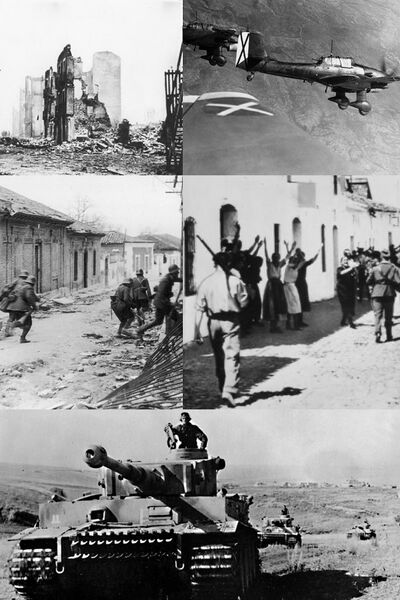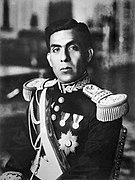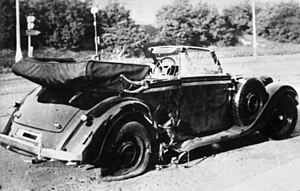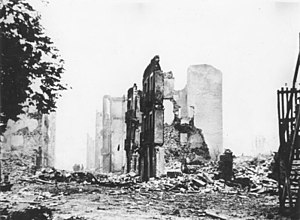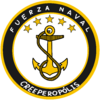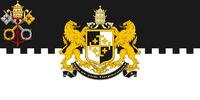Creeperian Civil War: Difference between revisions
No edit summary |
|||
| Line 226: | Line 226: | ||
| File:Hernandez Martinez.jpg | | File:Hernandez Martinez.jpg | ||
| alt1= | | alt1= | ||
| <center><small>[[Minister of Defense of Creeperopolis|MD]] [[Chief of the DINA|JDINA]] ''[[Chief Field Marshal (Creeperopolis)|JMC]]''</small><br />{{flagicon|Creeperopolis}} [[Adolfo Cabañeras | | <center><small>[[Minister of Defense of Creeperopolis|MD]] [[Chief of the DINA|JDINA]] ''[[Chief Field Marshal (Creeperopolis)|JMC]]''</small><br />{{flagicon|Creeperopolis}} [[Adolfo Cabañeras Moreno]]<br />(1890-1944)</center> | ||
| File:Presidente Jorge Ubico Castañeda.png | | File:Presidente Jorge Ubico Castañeda.png | ||
| alt2= | | alt2= | ||
| <center><small>[[Minister of Defense of Creeperopolis|MD]] [[Chief of the DINA|JDINA]] ''[[Chief Field Marshal (Creeperopolis)|JMC]]''</small><br />{{flagicon|Creeperopolis}} [[Alfonso Cabañeras | | <center><small>[[Minister of Defense of Creeperopolis|MD]] [[Chief of the DINA|JDINA]] ''[[Chief Field Marshal (Creeperopolis)|JMC]]''</small><br />{{flagicon|Creeperopolis}} [[Alfonso Cabañeras Moreno]]<br />(1892-1976)</center> | ||
| File:HTE Creeperopolis Coat of Arms.png | | File:HTE Creeperopolis Coat of Arms.png | ||
| alt3= | | alt3= | ||
Latest revision as of 17:44, 9 March 2020
The Creeperian Civil War (Creeperian Spanish: Guerra Civil Creeperiano) was a major civil armed conflict which took place in Creeperopolis. The Creeperian Civil War also spilled over into the kingdoms of Atlántida and Castilliano, as well as the Creeperian client state of El Salvador. The civil war lasted from January 2, 1933, to September 30, 1949.
The war was fought between the right-wing Catholic Imperial Restoration Council the left-wing National Council for Peace and Order. The Creeperian Civil War was the deadliest and bloodiest war in Creeperian history with up to 41.2 million Creeperans dead, and up to 52.2 million more wounded or missing. The war was marked by atrocities committed by both sides of the war, the Romerists against Communists and Atheists, and the Miguelists against Catholics. The war also saw heavy use of tanks, aircraft, chemical weapons, and air raids. Starting in 1933, the Miguelists initiated the Creeperian Genocide against Creeperian Catholics, Romerists, and Salvadorans.
Following the war, hundreds of Miguelists were executed for war crimes. All political parties, except the Creeperian Initiative, a merger of four political parties, were banned following the war. The Parliament was dissolved and was succeeded by the Council of Mayors.
Name
The "Creeperian Civil War" is often referred to by different names. It is often called the "Second Creeperian Civil War" as the War of the Creeperian Succession (1783-1790) is also referred to as the "Creeperian Civil War" or the "First Creeperian Civil War." Likewise, many also refer to this war as the "Second War of the Creeperian Succession" as monarchal succession plays a role in the cause for the war.
The war is also commonly called the "Second Creeperian Crusade" (particularly by Romerists and FRENAMI militants) due to the heavy religious nature of the war being the main driving force behind the war, similar to the Creeperian Crusade.
Background
Following the Revolution of 1833, the Creeperian Catholic Church was given full authority over the judicial aspect of the Empire, effectively establishing a theocracy in Creeperopolis. However, after the death of Emperor Adolfo III, Creeperian democratic movements marched on the San Salvador Imperial Palace and demanded that Parliament be reestablished. The new Emperor, Maximiliano II, caved into the demands and reestablished Parliament.
Several new parties were established forming two coalitions: the right-wing Creeperian Conservative Coalition (Coalición Conservador Creeperiano, CCC) and the left-wing People's Social Coalition (Coalición Social de los'Pueblos, CSP). The CCC generally pushed for religious pro-monarchy legislation while the CSP generally pushed for secular pro-republic/communist legislation.
The left leaning CSP managed to gain much influence in Creepeorpolis bringing the religious makeup from 89% Catholic and >.01% Secular in 1833 to 73% Catholic and 26% Secular by 1930. The CCC saw the increased secularization of the Creeperian population as an attack on the Catholic Church and on Creeperopolis' culture and tradition.
Prelude to War
On May 19, 1918, Prince Alfonso Adolfo Martínez Galdámez died from Creeperian Malaria. He was the brother of Prince Romero Adolfo Martínez Galdámez and Prince Miguel Adolfo Martínez Galdámez. Miguel was changed by the loss of his brother and began to believe that there was no God, that religion was all a lie and a fantasy. When his grandfather, Emperor Alfonso V Alexander Martínez Jiménez, died on June 3, 1918, his atheism was strengthened further. He envied his older brother's right of succession to the throne, then Grand Prince Romero. He believed that he was the rightful heir to the throne as he believed Creepeorpolis' tradition of Divine Right was nonsense. Many did not believe his arguments were not strong enough, which angered him further.
By 1925, Prince Miguel had begun to disfavor the monarchal system and began to admire the dictatorial system called for by communists in the Creeperian Social Communist Party at the time and began to align with the communist anti-monarchy CSP, while Grand Prince Romero aligned with the pro-monarchy CCC.
Emperor Adolfo IV took no action to block Prince Miguel's influence in Parliament and in Creeperian society as he feared beginning a civil war if he took such actions. He would fall ill to Creeperian Malaria in December 1932 however. Emperor Adolfo IV died on January 2, 1933 to Creeperian Malaria at 9:02am San Salvador Time (SST). The news was given to both Romero and Miguel, but both declared themselves the next rightful Emperor of Creepeorpolis.
Hearing the news of Romero I declaring himself Emperor, Miguel ordered that the Creeperian Armed Forces immediately have Romero I arrested. Romero I did the same, and ordered the Creeperian Armed Forces to immediately arrest Miguel VII. The Creeperian Armed Forces quickly splintered into factions of the armed forces backing Romero I while the other half supported Miguel VII.
Romero I ordered the Armed Forces loyal to him to not attack soldiers loyal to Miguel VII for the time being. Miguel VII did the same, and ordered the Armed Forces loyal to him to not attack soldiers loyal to Romero I for the time being. However, at 7:23pm SST, soldiers loyal to Romero I encountered troops loyal to Miguel VII in a barrack in San Salvador del Norte. Both forces were ordered to secure the barrack to prevent the other side from securing the weapons inside. At 7:25pm SST, firing began, and both sides started to fire on the other. The soldiers loyal to Miguel VII overran the soldiers loyal to Romero I and forced them to retreat the barrack. The soldiers loyal to Romero I took up positions one block from the barrack taking the city capitol turning it into their fortification. It remains a mystery who was the first to fire their rifle in the barrack.
Combatants
Romerists
| Part of a series on |
| Romerism |
|---|
 Cross of Creeperopolis (symbol of Romerism) |
|
The Romerists were fighting for Emperor Romero I (later Emperor Romero II), the Creeperian Catholic Church, and for (they claim) Jesus Christ, their declared Commander-in-Chief. Many Romerists saw the Creeperian Civil War as a Second Creeperian Crusade.
Among the Romerists were the Catholic Imperial Restoration Council (Consejo de Restauración Imperial Católico, CRIC), the Romerist declared provisional Creeperian government which would lead the Romerist cause of the War. The CRIC received support from the Creeperian Conservative Coalition (Coalición Conservador Creeperiano, CCC), who mostly agreed with the CRIC's ideologies of Catholic and Monarchal Restoration in Creeperopolis.
The CCC was composed of several parties with the major prties being the National Conservative Party (Partido Nacional Conservador, PNC), the Catholic Royalist Party (Partido Real Católico, PRC), and the Creeperian Pro-Fatherland Front (Frente Pro-Patria Creeperiano, FPPC). All parties were right-wing to far-right, supported the monarchy, and called for a Catholic Revival in Creeperopolis.
The Romerists didn't only receive significant political support from the Parliament, but also received significant support from the Creeperian Armed Forces, albeit half of the armed forces (as the other half joined the Miguelists), but also from two independent militant groups. The two groups were the Creeperian Peoples' Catholic Front (Frente Católico para el Pueblo Creeperiano, FCPC), also known as Cristeros, and the Militarist Nationalist Front (Frente Nacionalista Militar, FNM), also known as FRENAMI. The coalition was also supported by the Camisas Negras, the paramilitary wing of the FPPC. The FCPC was composed of mostly Creeperian civilians who joined the Romerists who fought against the Miguelists to secure themselves a safe Creepeorpolis to worship their God in peace, while FRENAMI was founded by Creeperian Army generals who believed vigilante justice was the only solution to end the war, and took it upon themselves to commit war crimes against the Miguelists.
The Romerists bore the imperial flag of Emperor Adolfo III from 1845-1887 as their banner.
Romerist Commanders
Romerist Emperors
Emperor of Creeperopolis and the Creeperans  Romero I
Romero I
(1899-1946, r. 1933-1946)Emperor of Creeperopolis and the Creeperans  Romero II
Romero II
(1930-1976, r. 1946-1976)
Romerist Military Commanders
MD JDINA JMC  Adolfo Cabañeras Moreno
Adolfo Cabañeras Moreno
(1890-1944)MD JDINA JMC  Alfonso Cabañeras Moreno
Alfonso Cabañeras Moreno
(1892-1976)MCP  Maximiliano Hernández Ramirez
Maximiliano Hernández Ramirez
(1891-1947)MCP  Máximo Barrueco Morterero
Máximo Barrueco Morterero
(1883-1954)CAU  Carlos Hernández Videla
Carlos Hernández Videla
(1895-1975)CAP  Enrique Figueroa Guerrero
Enrique Figueroa Guerrero
(1902-1943)CAP  Alexander Sánchez Molina
Alexander Sánchez Molina
(1905-1957)GEN  Adolfo Rivera López
Adolfo Rivera López
(1919-1981)MCP Luís Sánchez Cerro
(1889-1944)MCP Óscar Benavides Larrea
(1886-1959)MCP  Alfredo Figueroa Salinas
Alfredo Figueroa Salinas
(1888-1956)GEN  Tomás Alemán Prats
Tomás Alemán Prats
(1896-1957)
Romerist Political Leaders
PM  Máximo Illescas Freixa
Máximo Illescas Freixa
(1887-1965)PM  Rafael Antonio Gutiérrez
Rafael Antonio Gutiérrez
(1881-1957)CAU  Carlos Hernández Videla
Carlos Hernández Videla
(1895-1975)King of Castilliano José X
(1864-1937, r. 1922-1937)King of Castilliano José XI
(1898-1959, r. 1937-1949) Paúl Sáenz Mina
Paúl Sáenz Mina
(1897-1957)Supreme Pontiff Pio XII
(1876-1958, r. 1939-1958)
Miguelists
| Part of a series on |
| Miguelism |
|---|
Red Star (symbol of Miguelism) |
|
The Miguelists were fighting for Emperor Miguel VII (later Emperor Marcos I), for a Communist Creeperopolis, and for (they claim) the global Revolution, their final goal of the War. Many Miguelists saw the Creeperian Civil War as chance to spread Communism across the world in a global Revolution.
Among the Miguelists were the National Council for Peace and Order (Consejo Nacional para la'Paz y Orden, CNPO), the Miguelist declared provisional Creeperian government which would lead the Miguelist cause of the War. The CNPO received support from the People's Social Coalition (Consejo Social del Pueblo, CSP), who mostly agreed with the CNPO's ideologies of Communism/Socialism, abolition of the monarchy, and to establish a secular "democratic" Communist regime in Creeperopolis.
The CSP was composed of several parties the major parties being the National Liberal Party (Partido Liberal Nacional, PLN), the Creeperian Social Communist Party (Partido Communista Social Creeperiano, PCSC), and the Creeperian Socialist Party (Partido Socialista Creeperiano, PSC). All parties were left-wing to far-left, wished to abolish the monarchy, and called for a Communist/Socialist Revolution in Creeperopolis.
The Miguelists also received significant military support along with the political support. The Creeperian Armed Forces, albeit half of the armed forces (as the other half joined the Romerists) joined the Miguelist cause, but also did teo independent militant groups. The groups were the Senvarian Liberation Front (SLF) and the Atheist Red Army (Ejército Rojo Ateo, ERA), the paramilitary wing of the PCSC. The SLF's main goal was to gain independence from Creeperopolis and to establish their own Communist Senvarian and Senvekian state, which the Miguelists supported, and in tern received support back in the War against the Romerists. ERA's main goal was to eradicate religion in Creeperopolis.
The Miguelists bore a red flag as their banner.
Miguelist Commanders
Miguelist Emperors
Miguelist Military Commanders
Miguelist Political Leaders
Foreign Support
Foreign powers intervened and sent aid during the Creeperian Civil War.
The Romerists received diplomatic support from the Second State of the Church from 1933-1935. However, when the Miguelists invaded and attacked the nation in 1935, the State of the Church officially began sending military aid to the Romerists in what would become the Papal War which would rage until 1946. After the end of the Papal War, the State of the Church continued to aid the Romerists. The neighboring Kingdom of Castilliano, a Creeperian ally since the Creeperian Crusade, joined the Romerists a year after the War began in 1934, and they would continue to support the Romerists until the end of the War. The Kingdom of Atlántida joined the war on the side of the Romerists in 1939. Finally, the Romerists received trade and supplies from the Serene State of Quebecshire starting in 1935.
Progression of War
Outbreak, 1933-1935
After the skirmish in San Salvador del Norte, both Romero I and Miguel VII called upon their respective supporters to take up arms to fight the opposing side. The Parliament fractured into two between coalition lines. The Creeperian Conservative Coalition, with the support of Romero I, established the Catholic Imperial Restoration Council (Consejo de Restauración Imperial Católico, CRIC), the Romerist declared provisional Creeperian government which would lead the Romerist cause of the war. On the other hand, the People's Social Coalition, with the support of Miguel VII, established the National Council for Peace and Order (Consejo Nacional para la'Paz y Orden, CNPO), the Miguelist declared provisional Creeperian government which would lead the Miguelist cause of the war. (See Combatants). Each side significant recieved support from across the nation. The creation of the two opposing provisional governments de facto abolished the Second Creeperian Parliament. Parliament would not be officially dissolved until 1949.
Salvadoran Divide
On January 3, 1933, in order to gain the support of the underrepresented Salvadorans in the Creeperian client state of El Salvador, the Miguelists established the State of Granada, a puppet of the National Council. Miguel VII promised the Salvadorans a completely independent state if they help the Miguelists fight the Romerists. Salvadorans rallied to the cause of the Miguelists and the Salvadoran Peoples' Party officially endorsed the National Council. The Miguelists appointed Tomás Regalado Escalón as President of El Salvador on January 3, 1933. An election was schedualed for May 1933 to elect a President for Granada. The state was called Granada after the Granada River in an attempt to wipe Catholic influence from the region. The capital, Ciudad Los'Ángeles, was renamed to Ciudad de Granada as a part of the Miguelist Catholization process.
The Restoration Council denounced the creation of the State of Granada and reinforced the legitimacy of the Principality of El Salvador. Chief Field Marshal Adolfo Cabañeras Moreno was appointed as Regional Commander of El Salvador and Field Marshal Alfredo Figueroa Salinas was appointed as Regional Vice Commander of El Salvador. The Restoration Council gained the support of Paúl Sáenz Mina, a popular Salvadoran politician, to legitimize the Romerist government. Sáenz Mina's support for the Restoration Council curbed the popularity of the State of Granada, but only slightly.
The Romerists devised Operation Desert Valley. The plan was placed under the command of Adolfo Cabañeras Moreno. The Romerist Army held little territory in El Salvador due to the popularity of Tomás Regalado Escalón, with small pockets in the northeast, northwest, and southeast. Cabañeras Moreno's plan called for the Romerist Army to push south down the Granada River and secure the city of Ciudad Los'Ángeles. During Operation Desert Valley, Cabañeras Moreno committed many massacres to frighten the Salvadoran people into submission, the most famous of which being the El Mozote Massacre on January 13, 1934, which killed 5,200-5,500 Salvadoran civilians. The State of Granada used these massacres being committed by the Romerist Army as a propaganda tool to raise support and resitance against the Romerists. Serafín Mariano Aguinaldo won the 1933 Salvadoran Presidential Election with the endorsement of Tomás Regalado Escalón and promised to expel the Romerists from Granada by 1936, the year of the next election.
Miguelist Successes
When the civil war began, the National Council immediately gained the support of the cruitial city of Adolfosburg. The city was the most pro-CSP city in the nation and was one of the strongholds of the PLN. Since the National Council lost the capital of San Salvador and the major city of Salvador, Adolfosburg became the capital city of the National Council.
The National Council also gained the support of the Senvar-Senvekian minority in the departments of Senvar and Senvek. The National Council promised th Senvar-Senvekians an independent state as long they support the National Council in its struggle against the Restoration Council. The National Council also gained the overwhelming support of the minority Deltinians spread out across southern Creeperopolis, particularly the departments of Abdan, Helam, and Jakiz. Both the National Council and the Restoration Council despised the Deltinians, but the National Council tolerated the Deltinians to gain their support in the civil war.
General Juan Salinas Figueroa of the National Council, after the Miguelist victory in San Salvador del Norte, launched a massacre on January 5, 1933. The Tepecoyo Massacre killed 101 captured Romerist soldiers. Following the massacre, the Miguelist Army launched Operation Tepecoyo which saw the National Council capture all of San Salvador del Norte from Restoration Council hands by January 10, 1933. Tens of thousands of Romerists fled the department, most via Lake San Salvador to the department of San Salvador, which was mostly under Restoration Council control.
The First Massacres
In response to the massacre of 101 Romerist soldiers and the loss of San Salvador del Norte, Chief Field Marshal Adolfo Cabañeras Moreno committed four consecutive massacres in San Salvador and Zapatista which killed 321 people, mostly secular civilian supporters of the National Council. The Guazapa Massacre and Jutiapa Massacre took place in San Salvador while the Verapaz Massacre and the Oloculita Massacre took place in Zapatista. Salinas Figueroa followed Cabañeras Moreno south and committed the First Aguilares Massacre along the way killing 92 Romerist prisoners of war.
In March 1933, Cabañeras Moreno officially was reassigned to carry out Operation Desert Valley to liberate El Salvador from the State of Granada. When he arrived on March 6, 1933, his first action was to massacre the village of Tejutla where 23 civilians who were suspected of supporting Granada were killed. From there, Cabañeras Moreno would go on a spree of dozens and dozens of massacres killing thousands of suspected supporters of Granada, most of whom were civilians. The most infamous massacre committed by Cabañeras Moreno was the El Mozote Massacre in the village of El Mozote. An estimated 5,200 to 5,500 civilians were was slain by the Romerist Army on January 13, 1934. The El Mozote Massacre would be followed up by the Sumpul River Massacre and the El Calabozo Massacre which killed 1,300 to 1,600 civilians and 1,700 to 1,800 civilians, respectively.
Rise of the Cristeros
Around April 1933, with the Miguelist Armed Forces and the National Council gaining considerable ground, a group of Catholic civilian farmers formed. The armed civilian militia, called the Creeperian Peoples' Catholic Front, declared allegiance with the Romerist Restoration Council. The group upheld the ideologies of Romerism and demanded that National Catholicism be instituted across Creeperopolis. The FCPC was lead by Enrique Figueroa Guerrero.
The Restoration Council immediately accepted the aid of the group, who nicknamed themselves "Cristeros." In response, the National Council declared a no-quarter on all captured Cristeros, opting to hang captured Cristeros from telephone polls across Creeperopolis.
The Cristeros claimed to be composed of 3,000 farmers fighting for Jesus Crhist.
Execution of Former Prime Ministers
On February 23, 1934, the Romerist Army captured and arrested two former Prime Ministers of Creeperopolis: Serafín Velázquez Andrade, and independent with CSP sympathies, and Jorge Meléndez Ramírez, a member of the Creeperian Socialist Party. Both former Prime Ministers supported the National Council in the initial divide of the Parliament. Chief Field Marshal Adolfo Cabañeras Moreno ordered their execution. Velázquez Andrade and Meléndez Ramírez were executed on March 1, 1934.
Rise of the Senvar-Senvekians
In June 1934, Field Marshal Máximo Barrueco Morterero launched Operation Emperador Adolfo III. The operation called for a Creeperian Army offensive deep into Senvar and Senvek. The primary objectives were to secure the two departments, gain the support of the Senvar-Senvekians with promises of greater autonomy, and to secure the strategi cities of Port Senvar and Port Senvek.
Barrueco Morterero was under the direct orders of Cabañeras Moreno to not commit any massacres as to not anger the Senvar-Senvekians to launch an all out revolt against the Restoration Council. Barrueco Morterero followed orders and did not massacre any villages during his offensive.
By October 1934, the Romerist Army occupied nearly 95% of Senvar and Senvek, much to the dismay of the National Council and to the great dissaproval of the Senvar-Senvekians, who were looking forward to an independent state offered by the National Council.
Thhe Romerist Army saw the city of Port Senvar only two miles away. However, on October 5, 1934, a squadron of Romerist soldiers was ambushed by an armed militia of Senvar-Senvekian peasants near the village of Gänserntrenk. The 8,000 peasants overran the Romerist squadron and pushed them three miles north, effectively ending Operation Emperador Adolfo III. Soon, Senvar-Senvekian peasants rose up across Senvar and Senvek in the wake of the victory at the Battle of Gänserntrenk. A massacre of 1,094 prisoners and civilians ensued.
The Senvar-Senvekians proclaimed the establishment of the Republic of Senvar-Senvek on October 5, 1934. Adam Schuessler, a descendant of the Kings of the Kingdom of Senvar-Senvek proclaimed himself President of the republic. The following day, the National Council declared that Operation Schuessler, the covert operation to grant the Senvar-Senvekians a state, was successful and that the new republic had a strong ally in the National Council. The army of the new republic was called the Senvarian Liberation Front.
In the wake of this proclamation, an estimated 250,000 Senvar-Senvekians rose up in the neighboring Kingdom of Castilliano demanding secession. King José X denounced the uprising of the Senvar-Senvekians and declared war on Senvar-Senvek. He proclaimed to ally Castilliano with the Restoration Council. He cited the long standing alliance between Creeperopolis and Castilliano which has stood strong since the Creeperian Crusade back in 1231.
Fall of Granada
Throughout 1934 and early 1935, Adolfo Cabañeras Moreno continued Operation Desert Valley down south along the Granada River, massacreing several villages along the way. The popularity of Granada remained strong and many Salvadorans, officially callaed Granadians by the National Council and the State of Granada, sought refuge from the terror of Cabañeras Moreno. President Serafín Mariano Aguinaldo called for all Granadian men and women to resist the Romersit Army's advance south. However, many Granadians feared being tortured and massacred for attempting to fight back against Cabañeras Moreno. By March 1935, Salvadorans began to accept the Romerist advance and many fled to Romerist held territories, away from the massacres of Cabañeras Moreno.
The Romerist Army reached Ciudad de Granada on June 15, 1935. A month long battle ensued between the Romerist Army and the joint Miguelist-Granadian Army garrison in the city. The Battle of Ciudad Los'Ángeles, called the Battle of Ciudad de Granada by the Miguelists, ended in the surrender of the city to the Romerists on July 16, 1935, ending the Salvadoran War. The Miguelist Army withdrew from El Salvador essentially abolishing the State of Granada. Major Granadian figures such as Generals Simón Berganza Gallo and Lucián Céspedez Reyes and Presidents Tomás Regalado Escalón and Serafín Mariano Aguinaldo were executed for collaborating with the National Council on August 1, 1935.
Stalemate, 1935-1939
Following the fall of Ciudad Los'Ángeles to the Imperial Council in July 1935, an effective stalemate occured on nearly all fronts. Juan Salinas Figueroa and Alfonso Cabañeras Moreno continued to battle each other in the north over the departments of La'Libertad, San Romero, and Salvador, with neither side being able to overpower the other. Meanwhile, Adam Schuessler and Adolfo Cabañeras Moreno were trapped in a stalemate in southern Creeperopolis fighting for control of Senvar, Senvek, and Santa Ana. Castillianan King José X sent four armies under the control of Field Marshals Luís Sánchez Cerro and Óscar Benavides Larrea to Senvar and Senvek to fight against the Senvar-Senvekians, the first direct support the Castillianans sent to the Imperial Council.
War for the Papal State

Both the National and Imperial Councils developed plans to end the stalemante and to turn the tide of the war in their favor. Miguelist Field Marshal Juan Salinas Figueroa created a plan which was approved by Miguel VII. The plan, called Operation State Secularism, was the planned invasion, occupation, and annexation of the State of the Church. The plan also involved assassinating Pope Pio XII in an attempt to shatter the morale of the pious Creeperian Catholics in an order to shatter resistance to the National Council and to diminish support of the Imperial Council.
On October 12, 1935, the 5th Miguelist Army marched into the Papal State from the south with the goal of capturing and securing the city of San Salvador del Oeste and capturing and killing Pope Pio XII. Field Marshal Juan Salinas Figueroa left Field Marshal Miguel Salinas Ortega in command of National Council forces in the north while he traveled south to command the war against the Papacy. The National Council was supported by the Senvarian Liberation Army which was composed mostly of Senvar-Senvekian Protestants and the Atheist Red Army.
From October 1935 through May 1936, the National Council occupied over 70% of the Papal State. The National Council laid siege to San Salvador del Oeste beginning in May believing the city would fall by late-June. However, the Romerist Air Force heavily bombarded the besieging forces, and with a large Romerist relief force approaching, the Miguelists were forced to drop the siege by mid-June, effectively ending Operation State Secularism.
First Battle of La'Libertad
Following the departure of Juan Salinas Figueroa, Alfonso Cabañeras Moreno sought a way to take advantage of the new Miguelist commander, Miguel Salinas Ortega. The National Council had control of the city of La'Libertad and the city served as the National Council's de facto capital while the Imperial Council controlled San Salvador. Cabañeras Moreno wanted to capture the city in an attempt to cause chaos in the Miguelist logistical system causing a disorder in leadership.
On March 17, 1936, the Imperial Council initiated combat with the National Council in La'Libertad. The attack was immediately bogged down by strong Miguelist fortifications and Miguelist artillery defense. By April 9, 1936, Imperial Council forces in La'Libertad were running low on supplies. Alfonso Cabañeras Moreno ordered a retreat from the city, ending the First Battle of La'Libertad with a National Council victory. During the retreat, Cabañeras Moreno massacred 340 Miguslist prisoners of war.
Deltinian Uprising
The Deltinian people of southern Creeperopolis (mostly located in the departments of Abdan, Helam, and Jakiz) have been ruled by the Creeperans since the conclusion of the Creeperian Crusade which brought an end to the Deltinian Caliphate and its rump successors of the emirates of Abdan, Helam, and Jakiz in 1345. The Deltinians felt oppressed by the Creeperans and desired independence from any Creeperian government.
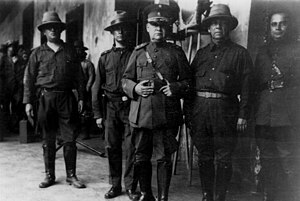
On May 5, 1937, Deltinian Muslim peasants in the departments of Abdan, Helam, and Jakiz revolted against the rule of the National Council. The Deltinian peasants were lead by Muammar al-Koroma. The peasants demanded total independence from the Imperial and National Councils for Abdan, Helam, and Jakiz, and called for support and aid from Greater Sacramento. The government declined to send direct aid but offered the Deltinians asylum in accordance with the 1853 Sacramatian Asylum Act. Before the Deltinians could accept the offer, National Council soldiers under General Pascual Espinar Casaus massacred 3,193 Deltinians, effectively suppressing the revolt on May 17, 1937.
Following the Miguelist massacre of Deltinians, General Máximo Barrueco Morterero launched an offensive into the departments of Abdan, Helam, and Jakiz in order to "liberate" the Deltinians from atheist hands in August 1937. From August 1937 until January 1938, the Imperial Council made minimal gains. The offensive was forced to be cancelled in February 1938 due to a lack of supplies to continue the offensive. The Imperial Council fortified the frontline which had been established.
Northern Offensive
After the Southern Offensive of 1937-1938 generally failed, only resulting in the capture of Port Senvar, Alfonso Cabañeras Moreno planned a new northern offensive to take control of the department of San Miguel, which was renamed to "Emperador Miguel" in order to de-Catholicize the name. The offensive began in June 1938 and continued throughout 1938 ending in March 1939 with the fall of the city of San Miguel on March 2, 1939.
During the offensive, the Imperial Council launched a campaign of indescriminate murder against athiests in the department. Soldiers would crucify and burn atheists alive, a practice still carried out by villagers in the department in the present as a form of extrajudicial execution.
The Dark Years, 1939-1944
The Dark Years in Creeperian history refers to a period of time from 1939 and through 1944 where Creeperopolis experienced hundreds and hundreds of massacres and mass murders of civilian populations.
Creeperian Genocide
The Creeperian Genocide, also known as La'Gran Matanza, was the genocide of Creeperian Catholics, Romerists, and Salvadorans which took place during the civil war. Between 1933 and 1949, across National Council controlled territories of Creeperopolis, the National Council systematically murdered around 9 to 11 million Catholics, Romerists, and Salvadorans, along with any National Council dissidents or deserters. The murders were carried out in pogroms, mass executions, mass shootings, and by a policy of extermination through labor in quarries, farmland, and mines.
Massacres, looting, and pillaging were also commonly committed by the Miguelists such as the 1944 La'Libertad Massacre, the 1947 San Salvador Massacre, and the 1948 Burning of North San Salvador. The genocide was pushed for by Miguelist Emperors Miguel VII and Marcos I and was carried out by the Creeperian Armed Forces loyal to the National Council, with assistance from the separatist Senvarian Liberation Front. Groups such as the Creeperian Peoples' Catholic Front, also known as the Cristeros, were created to fight against the National Council and their genocide. The genocide reached its deadliest point during the Dark Years.
Continued Cabañeras Massacres
Adolfo Cabañeras Moreno was a major figure during the Dark Years of Creeperian history.
During the Dark Years, massacres, genocide, ethnocide, and crimes against humanity were widespread, with Cabañeras himself personally ordered the killings of thousands Senvarian and Senvekian soldiers during the Papal War from 1939-1944. The Huizúcar Massacre was the first massacre which openly targeted Senvarian civilians which occurred on the Senvar-Zapatista border in 1940. The massacre claimed 2,300 civilian lives. The Huizúcar Massacre was responded to by the Talnique Massacre where the Senvarian Liberation Front executed 729 Creeperian prisoners of war and 211 civilians.
Each side committed massacres back and forth claiming to “retaliate” and “take revenge” for the previous massacre. Almost all of the massacres committed by both sides were ordered to be committed directly from commanding authorities. Cabañeras himself is responsible for and ordered at least 100 massacres and, at the maximum, up to over 400 massacres, by far the most of any commanding general of either side and even more than Adolfo Rivera López, the commander of the death squad Sombra Negra.
Assassination of Adolfo Cabañeras Moreno
On May 9, 1944, Cabañeras Moreno was on his way to a generals’ meeting near La’Libertad regarding the Second Battle of La'Libertad when he was assassinated by members of the Atheist Red Army disguised as photographers who threw and anti-tank grenade at his car. The grenade killed Cabañeras, the driver, and Castillianan Field Marshal Luís Sánchez Cerro instantly. The two assassins were injured and knocked over by the grenade. Both were killed on site by the military escort.
Cabañeras Moreno’s death was a major blow to Romerist morale and brought the Papal War to a temporary stalemate. His brother, Alfonso Cabañeras Moreno, was appointed as Minister of Defense and he would continue the Papal War in the south. His death also brought an end to the Dark Years and massacres became less frequent.
Denshire Massacre
In retaliation for Cabañeras Moreno’s death, the Militarist Nationalist Front, under the direct orders of Adolfo Rivera López, massacred over 25,000 civilians, mostly exiled Deltinians, in what became known as the infamous Denshire Massacre.
On June 13, 1944, soldiers of the Sombra Negra mercilessly and indiscriminately killed anyone in the city of Denshire, the capital city of the department of Jakiz, who was either ethnically Deltinian or a follower of Deltinian Islam. Men, women, and children were all killed with no one being spared. Women were raped by the soldiers and mosques were set on fire. Civilians of non-Deltinian descent who attempted to hide or protect Deltinians or tend to the wounded were also killed. Despite the city being held by the Catholic Imperial Restoration Council with a garrison of 10,000 Romerist Army soldiers stationed in the city, they did little to nothing to prevent the massacre at best, and assisted in the killings at worst. The general of the Sombra Negra, Adolfo Rivera López, personally ordered, commanded, and took part in the massacre.
Continued Stalemate, 1944-1946
Late War Progress, 1946-1949
Siege of San Salvador
Final Months of Civil War, 1949
Surrender and Peace, 1949
Aftermath
Weapons and Technology
Atrocities
Romerists
Miguelists
The Creeperian Genocide
Support for the War
Support for the war was almost non-existent during the first two years, with the only support coming from die-hard Romerists/Miguelists and the Creeperian Armed Forces. However, as the war grew deadlier, massacres became common place, and the Catholic Church was beginning to be attacked, support quickly grew and the war turned into a total war on both sides. By 1940, essentially the entire nation was at was with itself with every family aiding the war effort in one way or another.
Opposition to the War
Opposition to the war was nearly universal during the first two years of the war when the least bloodshed occurred. However, as the war grew deadlier, massacres became common place, the Creeperian Catholic Church was beginning to be attacked, and the beginning of the Creeperian Genocide opposition quickly fell.
Legacy
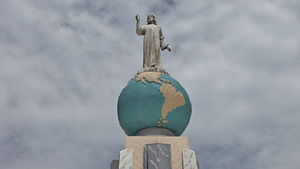
Many memorials have been constructed through both public and private funding to commemorate the Creeperian Civil War, the Romerists, and the Martyrs who died in the war. The War heavily influenced Creeperian culture and pushed for a renewal in Creeperopolis' Catholic spirit, a second "Renaissance" like the one seen after the conclusion of the Creeperian Crusade in 1345.
The most notable Creeperian Civil War memorial is El Salvador del Mundo y la'Humanidad, "The Savior of the World and Humanity" in English. The war memorial was built in 1968 as a commemoration to the millions of Romerists who gave their life for Creeperopolis.
